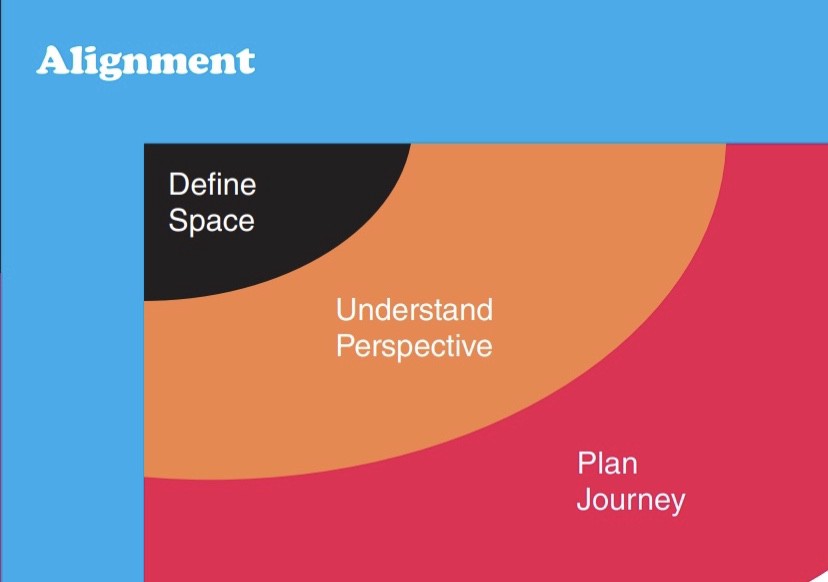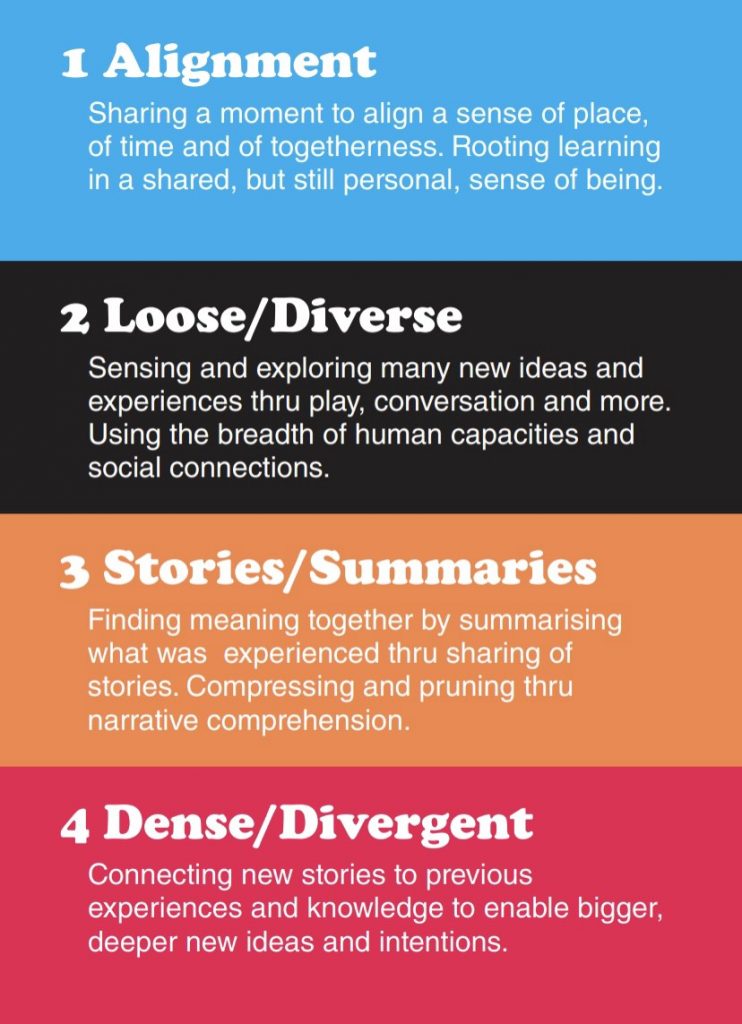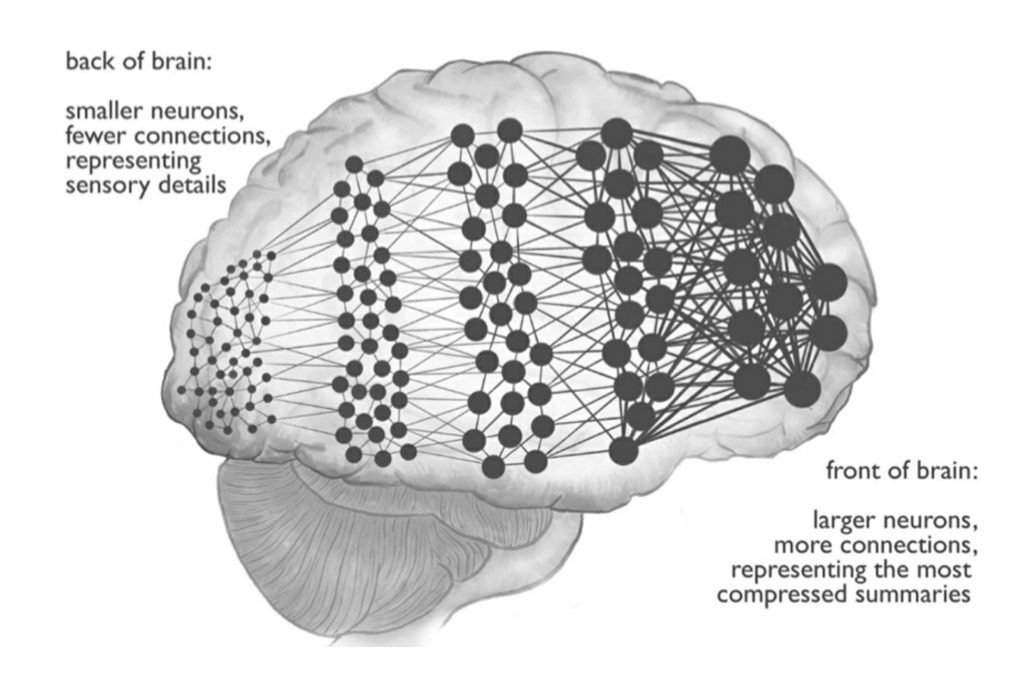
This post is a few notes on some ideas raised during the Unlearning Design Thinking workshop at the 2021 Information Architecture Conference. They do not replace the basic ideas of Design Thinking (popularised in the Stanford/Google/Double Diamond models). What I am attempting is to use the idea of Alignment to bring system thinking models closer to how human think.
I am now using three postcards to explain these ideas. I will be running some online/offline workshops later this year.
This post has three main sections:
- Alignment
- Wayfinding
- Network Thinking
Alignment

Alignment has been coming up in a lot of my reading over the last year. In books on Time Perception, Dissent, Kindness and Leadership it’s the anchor of alignment that comes thru as a common theme. The need to be aligned at the start of a project or journey but also the need to be deeply wary of alignment as the project or journey continues.
Alignment in place, in time and in social connection is crucial to any project. Fail to be explicit about the rituals of starting a journey together and the journey will be much harder and the final destination may be very disappointing. Humans need a sense of where, when and who they are at the start.
However, that need for alignment at the start of the journey is too often confused with a need to maintain alignment thru the journey. Particularly with projects this is not good. Strong alignment over the project gets caught up in ideas of leadership, management, timekeeping, meeting attendance, convergence and group think. All of these can be damaging when too strongly applied. Diversity and divergence cannot thrive when uniformity and convergence are applied in all places, at all times for all people.
The key point here is to spend more time at the start ensuring people feel a shared sense of being together and then progressively let go. In one book on Mesolithic societies, it is interesting how leadership was an intervention, a momentary role not a permanent position or structure. Using power temporarily to align people is good. Using power permanently to control people is not.
Aligment means organisations putting more effort into things before they start the thing they believe is the project. Good alignment anchors people to good outcomes which may well be vastly different to what was imagined at the start.
Wayfinding

I help design tactile maps with blind people. How humans think about maps and journeys is hugely important to me. Last year’s book Wayfinding by Michael Bond was very good on ideas about how humans think about maps, move and get lost. It was also useful for pointing out that the cognitive maps we make for physical journeys are the same kinds of map we make for all information we encounter. Wayfinding is the basis for embodied learning.
Wayfinding is too often thought of in terms of maps, touchpoints and signposts giving clear direction. However, this is the last part of this ABCD methodology. It is last because the over-use of such maps, touchpoints and signposts mean that personal autonomy is minimised, dependence on the system is too great and individual agency when getting lost is, well, lost.
Therefore Wayfinding starts with individual perception from personal perspective.
It starts with alignment. The basic sense of which way are you pointing at the start of a journey.
Failing to know your alignment at the start means the rest of the trip can be confusing. Many people know this sense of a permanent cascade of lostness when they come out of a new travel hub (railway station, metro station, etc.) and do not quite know which way they are pointing. The lack of a good anchor affects all the cognitive maps and choices made thru the journey. Even when encountering familiar places, they are askew. All because the first moment of alignment failed.
Boundaries matter in terms of giving a human-scale sense of place and a cognitive sense of effort required. Having a sense of the edges means it is possible to have a sense of place and how long it will take to cross it.
The digital experience of places without boundaries is found in Doomscrolling. People flicking on and on thru Twitter or Facebook because it never ends. With no edges, there is no place, with no sense of place then the sense of time is lost: and suddenly it’s 1am and you have not gone to sleep (again).
Centered is ensuring we respect not merely how people observe a new journey but how they move they a novel space. We use Grid Cells to make multiple cognitive maps as we move thru a place. Each map has different scales because they center on our sense of physicality and social connection. We are centered in both our bodies and our societies. Being human is both individual and communal. Alone and together. We shift and shimmy between these senses of being. The body is, for the most part, the best center for this.
Direction is that final sense of providing the cues and hints that help people get from A to B. From where people start from to where they want to be.
Understanding wayfinding is the frame for a journey that starts in alignment.
Network Thinking

The last of the three postcards is about the idea of Network Thinking. This draws from some points made in Lisa Barrett Feldman’s last two books (Seven and a half lessons about the brain and How emotions are made) on the neuroscience of Human Brain networks.
She points out that most ideas about the brain are metaphors but one actual truth is the network of the brain. This diagram shows how we abstract meaning from senses.

What this led me to think about was a metaphor about learning and thinking that aligns with this sense of different networks interacting.

What this shows is an idea of diversity being fundamental to learning and divergence to understanding; all filtered thru stories. This is the Network Thinking concept is about: putting diversity and divergence at the centre of design thinking. This relates directly to my interest in Post Normal Design that is not anchored to the needs of White Men.
In terms of the postcard, it is a process of recognising the need for many people and many ideas at the start of a project. This is why alignment (again) matters so that the process starts in diversity rather then seeking it out later. Loose/Diverse means being open to lived as well as professional experiences. Holding off judgement, holding open doors to explore more and imagine more.
How to compress many ideas into usable themes is always a problem. Compressing it into data is one method, a more human-centered one is using storytelling. Our brains summarise sensory data: they prune and discard to form ideas that can be intergrated into existing and emergent networks. Centering on sharing stories is also how we mix that sense of being individual and communal. What makes sense to us in a story when we read it alone can be very different to what happens to meaning when we tell a story out loud in a group.
Finally, Dense/Divergent: the awesome capacity of humans to imagine and make things that have never existed before. How we can diverge from what has happened historically because we can make complex new ideas out of old and new experiences. Respecting that density of human knowledge within us and using it within us as individuals and between us as communities.
Network Thinking uses meta-cognition to center not on design systems but humans and their diversity. We need to tools that respect our individuality and the strength found in how we differ. Breaking away from a fake sense of uniformity (or Normal) and losing the demand for convergence (or compliance to Normal).
Alignment, Wayfinding, Network Thinking
That is the three parts.
All anchored in Alignment and framed by both Wayfinding and Network Thinking.
Not replacing design thinking but just offering some alternative ways of putting more humans at the center of it.
- Alignment and how we think about starting
- Wayfinding and how we think about moving
- Network Thinking and how we think about sensing, storytelling and thinking
The three ideas crossover because:
- Alignment is fundamental to all of them
- Defining space comes thru both seeking boundaries and perceiving the diversity of people, artefacts and ideas in that space
- Understanding perspective comes from both centering to our personal experience and sharing stories to make meanings together
- Planning journeys comes from both having a sense of direction and a thoughtful sense of which direction to choose from the many available
How we start, how we move and how we think are all linked because we are embodied beings settled into networks within and around ourselves.
I will be doing some workshops soon. Let me know if you would like to attend (email a.somerville@acuity.design).